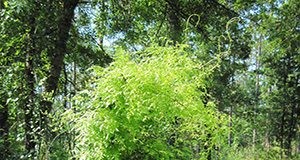Abstract
El helecho trepador japonés es una enredadera invasiva no nativa de los Estados Unidos (EEUU) que fue introducida aproximadamente en 1900. Este helecho se ha establecido a lo largo de la llanura costera del sudeste de los EEUU desde los estados de Norte y Sur Carolinas hasta Texas y Arkansas. El helecho trepador japonés es nativo de Asia, en particular Japón así como al oeste de la cordillera de los Himalayas. El área de establecimiento se ha expandido desde la región de la costa del Golfo de México incluyendo TX, AR, LA, MS, AL, FL, GA, SC, NC, y PA. En Florida, el helecho trepador japonés está ampliamente distribuido en el norte y al oeste del estado, mientras que en la parte centro-sur su abundancia es variable. Este helecho está adaptado a lugares soleados o con sombra, y por lo general se localiza en suelos húmedos como los bordes de los pantanos, lagos, arroyos y bosques de tierras altas.
This revised 6-page fact sheet was written by Elsa D. Chevasco, Patrick J. Minogue, Kimberly K. Bohn, and Francisco Escobedo, and published by the UF Department of School of Forest Resources and Conservation, November 2016.
FOR282/FR344: Control y Biología del Helecho Trepador Japonés (Lygodium japonicum) (ufl.edu)
References
Bohn, K.K., M. Thetford, and P.J. Minogue. 2014. Effect of herbicide type, application timing, and light intensity on Japanese climbing fern reproduction. Florida Fish and Wildlife Conservation Commission, Bureau of Invasive Species Management Final Report. 13 pp.
Bohn, K.K. and P.J. Minogue. 2011. Assessing the timing and sequence of prescribed fire and herbicide applications on the control of the invasive Japanese climbing fern two years after treatment. Florida Fish and Wildlife Conservation Commission, Bureau of Invasive Species Management Final Report. 10 pp.
Bohn, K.K., P.J. Minogue, and E.C. Pieterson. 2011. Control of invasive Japanese climbing fern (Lygodium japonicum) and response of native ground cover during restoration of a disturbed longleaf pine ecosystem. Ecological Restoration 29:346-356. https://doi.org/10.3368/er.29.4.346
Evans, C.W., D.J. Moorhead, C.T. Bargeron, and G.K. Douce. 2006. Invasive Plant Responses to Silvicultural Practices in the South. University of Georgia Press.
Ferriter, A. ed. 2001. Lygodium management plan for Florida: A report from the Florida Exotic Pest Plant Council's Lygodium Task Force. Florida Exotic Pest Plant Council. Orlando, FL. 51 pp.
FLEPPC. 2016. Florida Exotic Pest Plant Council Invasive Plant Lists. http://www.fleppc.org/list/list.htm (accessed September 2016)
Jose, S., J. Cox, D.L. Miller, D. G. Shilling, and S. Merritt. 2002. Alien plant invasions: the story of cogongrass in southeastern forests. Journal of Forestry 100:41-44.
Langland, K.A., S.F. Enloe and J. Hutchinson. 2016. Natural Areas Weeds: Old World Climbing Fern (Lygodium mycrophyllum). AG122. Gainesville: University of Florida Institute of Food and Agricultural Sciences. https://edis.ifas.ufl.edu/ag122 (accessed September 2016) https://doi.org/10.32473/edis-ag122-2016
Langland, K.A., and K. Craddock Burks (ed.). 1998. Identification and Biology of Non-Native Plants in Florida's Natural Areas. Gainesville: University of Florida Institute of Food and Agricultural Sciences. 165 pp.
Lott, M.S., J.C. Volin, R.W. Pemberton, and D.F. Austin. 2003. The reproductive biology of the invasive fern Lygodium microphyllum and L. japonicum (Schizaeaceae): Implications for invasive potential. American Journal of Botany 90:1142-1154. https://doi.org/10.3732/ajb.90.8.1144
Miller, J.H. 2007. Non-native Invasive Plants of Southern Forests. US Department of Agriculture, Forest Service, Southern Res. Stn., Gen. Tech. Rpt. SRS-62. 93 pp.
Minogue, P.J., K.K. Bohn, A. Osiecka, and D.K. Lauer. 2010. Japanese climbing fern (Lygodium japonicum) management in Florida's bottomland hardwood forests. Invasive Plant Science and Management 3:246-252. https://doi.org/10.1614/IPSM-D-09-00023.1
Munger, G.T. 2005. Lygodium spp. In: Fire Effects Information System. U.S. Department of Agriculture, Forest Service, Rocky Mountain Research Station, Fire Sciences Laboratory (Producer). http://www.feis-crs.org/feis/ (accessed November 2016)
Nelson, G. 2000. The Ferns of Florida. Pineapple Press, Sarasota, Florida. 208 pp.
Pemberton, R. 2007. Lygodium biological control. 2007 Annual Report, USDA, Agricultural Research Service, Invasive Plant Research Laboratory, Ft. Lauderdale, FL. http://www.ars.usda.gov/research/projects/projects.htm?ACCN_NO=406789&showpars=true&fy=2007 (accessed November 2016)
Pemberton, R. 2002. Old-World climbing fern. In: Van Driesche, R. et al. (eds.) Biological Control of Invasive Plants in the Eastern United States. USDA Forest Service Publication FHTET-2002-04. 413 pp.
Pemberton, R. W. 1998. The potential of biological control to manage Old-World climbing fern (Lygodium microphyllum), an invasive weed in Florida. American Fern Journal 88:176-182. https://doi.org/10.2307/1547770
Pieterson, E.C., S. Jose, S.B. Jack, P.J. Minogue. 2008. Incorporating fire into an integrated pest management plan for Lygodium japonicum (Japanese Climbing Fern). Natural Areas Conference. October 15, 2008. Nashville, TN. http://www.naturalarea.org/conferenceAbstracts.aspx?s=Pieterson (accessed September 2016)
Roberts, D. 1997. Old-World climbing fern research and mitigation at Jonathan Dickinson State Park. Resource Management Notes. Florida Department of Environmental Protection, Florida Park Service. Orlando, FL. 9:30-32.
Stocker, R.K., A. Ferriter, D. Thayer, M. Rock, and S. Smith. 1997. Old-World climbing fern hitting South Florida below the belt. Wildland Weeds (Winter):6-10.
USDA, NRCS. The PLANTS Database. 2016. PLANTS profile: Lygodium japonicum (Thunb.) Sw. National Plant Data Center, Baton Rouge, LA 70874-4490: http://plants.usda.gov/core/profile?symbol=LYJA (accessed September 2016)
Valenta, J. T., M. Zeller, and A. Leslie. 2001. Glyphosate control of Japanese climbing fern in experimental plots (Florida). Ecological Restoration 19:118-119.
Van Loan, A. N. 2006. Aspects of the invasion and management of Japanese climbing fern (Lygodium japonicum) in Southeastern forests. Master's thesis. University of Florida. 119 pp.
Wunderlin, R.P., B.F. Hansen, A.R. Franck, and F.B. Essig. 2016. Lygodium japonicum, Atlas of Florida Plants [S. M. Landry and K. N. Campbell (application development), USF Water Institute] Institute for Systematic Botany, Univ. of South FL, Tampa, FL. http://florida.plantatlas.usf.edu/Results.aspx (accessed September 2016)
Wunderlin, R. P. and B. F. Hansen. 2006. Atlas of Florida vascular plants. University Press of Florida.
Zeller, M. and D. Leslie. 2004. Japanese climbing fern controls in planted pine. Wildland Weeds 7:6-9.

